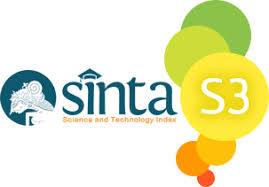Use of computer-mediated communication in online discussion forum
 Abstract views: 555
,
Abstract views: 555
,
 PDF downloads: 262
PDF downloads: 262
Abstract
The purpose of this study is to explore the usage of computer-mediated computer communication in online learning during the COVID-19 pandemic. This study focuses on how Universitas Multimedia Nusantara lecturers and students (UMN) build interaction for online learning. The research methodology used qualitative methods with six informants, and data generation was using in-depth interviews. The results indicated that most students positively perceived the online discussion forum as computer-mediated communication (CMC) in online learning during the COVID-19 pandemic. The students' perceptions are considered negative about lecturers' responses in the discussion forum because lecturers usually are late in replying to the student's questions. Students are satisfied with using computer-mediated communication in E-learning UMN, which has given many benefits in supporting online learning activities. The students need and expect the lecturers that they would have an enthusiastic attitude, provide immediate feedback, select the appropriate topic, and regularly participate in the online discussion forum.
References
Al-Kumaim, N. H., Alhazmi, A. K., Mohammed, F., Gazem, N. A., Shabbir, M. S., & Fazea, Y. (2021). Exploring the impact of the covid-19 pandemic on university students’ learning life: An integrated conceptual motivational model for sustainable and healthy online learning. Sustainability (Switzerland), 13(5), 1–21. https://doi.org/10.3390/su13052546
Arbaugh, J. B. (2018). Republication of “Virtual Classroom Characteristics and Student Satisfaction with Internet-Based MBA Courses.” Journal of Management Education, 42(4), 533–556. https://doi.org/10.1177/1052562918770400
Carr, C. T (2021). Computer Mediated Communication: A Theoretical and Practical Introduction to Online Human Communication. London: Rowman & Littlefield Publishing Group.
Creswell, J. W. & Poth, C. N. (2018). Qualitative Inquiry & Research Design- Choosing Among Five Approaches, 4th Edition. Los Angeles: Sage
Jordan, R. (2008). Preparing Participants for Computer Mediated Communication. In Kelsey (Ed.) Handbook of Research on Computer Mediated Communication (pp. 25 – 33). New York: InformatIon scIence reference.
Gillis, A., & Krull, L. M. (2020). COVID-19 Remote Learning Transition in Spring 2020: Class Structures, Student Perceptions, and Inequality in College Courses. Teaching Sociology, 48(4), 283–299. https://doi.org/10.1177/0092055X20954263
Griffin, EM. (2019). A First Look at Communication Theory, 10th Edition. New York: McGraw Hill
Kachani, S. (2016). Guide for Inclusive Teaching at Columbia. Retrieved from https://ctl.columbia.edu/resources-and-technology/resources/inclusive-teaching-guide/
Kurek, M., & Müller-Hartmann, A. (2019). The formative role of teaching presence in blended Virtual Exchange. Language Learning & Technology, 23(3), 52–73. http://hdl.handle.net/10125/44696
Muthuprasad, T., Aiswarya, S., Aditya, K. S., & Jha, G. K. (2021). Students’ perception and preference for online education in India during COVID -19 pandemic. Social Sciences & Humanities Open, 3(1), 100101. https://doi.org/10.1016/j.ssaho.2020.100101
Neuman, W. L. (2014). Social Research methods-Qualitative and Quantitative Approaches 7th Edition. USA: Pearson Eduction Inc.
Ngussa, B. M. (2018). Correlates of experiential learning in English subject among teacher trainees in Arusha City, Tanzania. International Journal of Educational Policy Research and Review Vol.5 (7), pp. 100-108. https://doi.org/10.15739/IJEPRR.18.012
West, R. & Turner, L. H. (2019). Introducing Communication Theory: Analysis and Application, 6th Edition. New York: McGraw Hill
Zhu, P., & St.Amant, K. (2010). An Applicationof Robert Gagné’s Nine Events of Instruction to the Teaching of Website Localization. Journal of Technical Writing and Communication, 40(3),337–362. https://doi.org/10.2190/TW.40.3.f
Copyright (c) 2022 Jurnal Komunikasi Profesional

This work is licensed under a Creative Commons Attribution-ShareAlike 4.0 International License.

Jurnal Komunikasi Profesional is licensed under a Creative Commons Attribution-ShareAlike 4.0 International License.
1. Proposed Policy for Journals That Offer Open Access
Authors who publish with this journal agree to the following terms:
- Authors retain copyright and grant the journal right of first publication with the work simultaneously licensed under a Creative Commons Attribution License that allows others to share the work with an acknowledgment of the work's authorship and initial publication in this journal.
- Authors are able to enter into separate, additional contractual arrangements for the non-exclusive distribution of the journal's published version of the work (e.g., post it to an institutional repository or publish it in a book), with an acknowledgement of its initial publication in this journal.
- Authors are permitted and encouraged to post their work online (e.g., in institutional repositories or on their website) prior to and during the submission process, as it can lead to productive exchanges, as well as earlier and greater citation of published work (See The Effect of Open Access).
2. Proposed Policy for Journals That Offer Delayed Open Access
Authors who publish with this journal agree to the following terms:
- Authors retain copyright and grant the journal right of first publication, with the work [SPECIFY PERIOD OF TIME] after publication simultaneously licensed under a Creative Commons Attribution License that allows others to share the work with an acknowledgement of the work's authorship and initial publication in this journal.
- Authors are able to enter into separate, additional contractual arrangements for the non-exclusive distribution of the journal's published version of the work (e.g., post it to an institutional repository or publish it in a book), with an acknowledgement of its initial publication in this journal.
- Authors are permitted and encouraged to post their work online (e.g., in institutional repositories or on their website) prior to and during the submission process, as it can lead to productive exchanges, as well as earlier and greater citation of published work (See The Effect of Open Access).



